Abstract
Aiming at addressing the problems that step-by-step sugarcane defoliation equipment cannot control, including the feeding amount of sugarcane, which is prone to clogging and needs to be fed manually, a sorting and conveying device for the front end of defoliation equipment was designed. A simulation model was created using ADAMS 2020 software to examine the impact of the cane collection plate’s inclination angle and the sprocket wheel’s rotational speed on the percentage of sorting three canes in a one-factor test. A two-factor three-level test was conducted by choosing an inclination angle of 25° to 35° and a sprocket speed of 24 to 28 r/min. According to the ANOVA results, the percentage of sorting three canes was significantly impacted by the sprocket’s rotational speed, the inclination angle of the cane collection plate, and the interaction between the two variables. Based on the interaction effect study, the best combination to affect the percentage of sorting three canes is a sprocket rotational speed of 24 r/min and a collection plate inclination angle of 35°. Finally, a physical prototype test validated the simulation data, and the results revealed that the percentage of sorting three canes in the physical prototype is 80.56%, with a relative inaccuracy of 8.4%.
1. Introduction
One of the world’s major cash crops for energy and sugar is sugarcane [1]. One of the world’s leading producers of sugarcane is in China [2], while the majority of China’s sugarcane-growing regions are located in Guangxi, Yunnan, Guangdong, and other provinces. The degree of mechanization of sugarcane harvesting in China is less than 5% [3], due to the country’s diverse terrain and lack of standardized standards for sugarcane cultivation. Sugarcane leaf stripping is an essential aspect of sugarcane harvesting, affecting the economic advantages of harvesting and sugar production for sugarcane farmers [4], and it is critical to create leaf stripping technology that is appropriate for China’s planting circumstances. Currently, sugarcane leaf stripping equipment primarily serves as a supporting part of the sugarcane combine harvester, which can perform both harvesting and leaf stripping simultaneously. However, the combine harvester’s leaf stripping [5,6] has a high impurity rate, is prone to clogging, and has an unstable operating performance. Therefore, Guangxi University proposed a step-by-step method for harvesting sugarcane that involves harvesting, transferring, and centralizing the leaf stripping of crops independently. This method can be used on small terrain, like hills and mountains, and has the advantages of being highly flexible, having a low rate of impurity during the leaf stripping process, and matching the sugar mill process in comparison to the cut-off type [7] and the whole culm type combine harvester.
Pull-type sugarcane defoliation equipment, developed by Guangxi University [8], was utilized as the main component of the step-by-step sugarcane harvesting mode. This equipment has numerous benefits over the conventional centrifugal defoliation [9,10] method, including a low rate of impurities, a low rate of damage, and a long service life of the defoliation elements. Nevertheless, pull-type sugarcane defoliation equipment still has limitations, including the requirement for even and systematic sugarcane spreading during feeding and the potential for clogging when the feeding volume is excessively high. The entire mechanical process has not yet been accomplished, and it is currently often utilized to physically aid in the sorting and feeding of sugarcane. Therefore, it is essential to design a conveying system that is compatible with the equipment used for step-by-step sugarcane defoliation.
Conveying systems are essential to the entire process of mechanically harvesting sugarcane. Scholars both domestically and internationally have conducted extensive studies on this topic in an effort to guarantee the integrity of sugarcane harvesting conveyor systems and lessen the obstruction of the sugarcane conveying process. Kent [11] observed through experimental research that keeping an appropriate speed during conveying will improve both the cutting quality of sugarcane and the stability of conveying. The authors in the literature [12,13] developed a small-scale sugarcane defoliator, which is manually fed into the sugarcane to finish the defoliation process, with a leaf removal rate of over 80%; nevertheless, the defoliator’s operational efficiency is only 2 to 3.5 t/h. Since the conveying system logistics volume is too large, Jadhav U et al. [14], employed the use of range sensors to scan through the cross-sectional area of an object, and calculate the total volume and mass of the logistics over some time, so that the volume of material flow can be reasonably controlled., And, through a test, they verified that it is feasible. The literature [15,16] describes the addition of internal cane splitters and auxiliary cane rollers to the conveying channel to restrict the direction of stray canes and lessen clogs brought on by cane stacking and accumulation. Yamada et al. [17] addressed the issues of conveyor system blocking and throughput maladaptation in reverse manufacturing equipment by developing state equations for conveyor system throughput, designing conveyor system parameters, and developing a probabilistic model of conveyor system blocking.
Xu et al. [18] devised feeding rollers with distinct structures, with the top roller having a serrated form and the bottom roller having a shuttle shape, which allows the sugarcane to expand to both sides when conveying, making the process smoother. Li Li [19] et al. identified the important elements influencing conveying capacity as structural parameters, traction force, and cane lifting angle by studying the logistical features of the conveying device and the force condition of the cane, and then conducted experiments to validate them. Shen et al. [20] addressed the problem of the high probability of clogging in the conveying system, simulated the conveying speed of sugarcane using Adams simulation software, and concluded that increasing the friction factor between the sugarcane and the screw, increasing the active feeding rollers, and increasing the rubber on the cutter shaft can increase the conveying speed of sugarcane, and reduce the probability of sugarcane clogging in the conveying system. Lai Xiao et al. [21] designed a whole stalk type sugarcane harvester conveying regulation system consisting of dynamic torque sensors, a PLC control system, a hydraulic system, and a servomotor system to address harvester cane conveying channel blockage, low efficiency, and a harvester feeding amount that is unable to be adjusted in response to the stochastic nature of sugarcane growth, among other issues. The test results reveal that the average blockage rate of this control system operation has decreased to 5%, which has a substantial effect on reducing the conveyor blockage. Zhou et al. [22] created a vertical leaf stripping mechanism to address the issue of lengthy cane passageways in the present whole stalk-type sugarcane combine harvester and lower the likelihood of an obstruction.
The preceding research focuses on reducing clogging difficulties by modifying the structure of the conveying channel, the morphology of the feeding roller components, the speed, or manual feeding, because there have been few studies on a conveyor mechanism for the front end of the leaf stripping equipment. To provide a reference basis for the research on the conveying system of distributed sugarcane leaf stripping equipment, this paper uses the pull-type leaf stripper developed by Guangxi University as the research object. It then designs a device for sorting and conveying sugarcane at the front end of the leaf stripper and investigates the sorting and conveying effect of the device through simulation tests and physical prototype verification. As a result, this paper takes the pull-type leaf stripper developed by Guangxi University as the research object, designs a device for sorting and conveying sugarcane at the front end of the leaf stripper, and studies the sorting and conveying effect of the device using simulation tests and physical prototype verification, to provide a reference for future research on the conveying system of distributed sugarcane leaf stripping equipment.
2. Materials and Methods
2.1. Overall Structure of Step-by-Step Sugarcane Leaf Stripping Equipment
The overall structure of the step-by-step sugarcane leaf stripping equipment is shown in Figure 1. Its primary components are a loading platform, a manipulator, a lifting conveyor belt, a cane collecting board, a sorting mechanism, a straight conveying channel, a leaf stripping box, a cane leaf recycling conveyor belt, a net cane collector, and additional mechanisms. The equipment works as follows: the manipulator picks up roughly fifty sugarcane stalks each time and distributes them between the loading platform and the lifting conveyor belt. The lifting conveyor belt then raises the stack of canes at a steady pace, and once it reaches the top of the conveyor belt, the sugarcane falls to the cane collection board. From there, they slide to the bottom of the cane collection board, where they are sorted by the sorting organization and moved for conveying. The sugarcane is conveyed in a sorting device to maintain its lateral state. The pull-type leaf stripping machine requires that the cane tail be fed first. The straight conveying channel and the sorting mechanism have a vertical layout. The cane changes direction and feeds into the leaf stripping box through the straight conveying channel. The process of stripping the sugarcane is finished once it enters the net cane collector. When the cane reaches a certain weight, the collector baffle plate will automatically open the sugarcane bundling loading trucks to finish the sugarcane leaf stripping operation. The sugarcane defoliation procedure has finished. Figure 2 displays the operation flow chart.
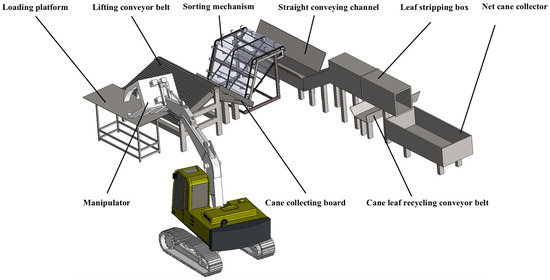
Figure 1.
Overall structure of step-by-step sugarcane leaf stripping equipment.
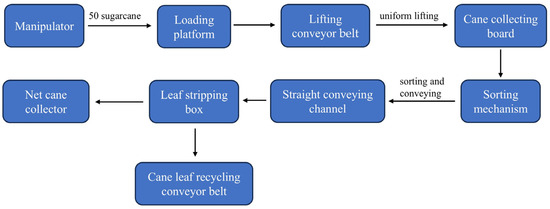
Figure 2.
Flow chart for sugarcane leaf stripping machine operation.
2.2. Design of Sorting and Conveying Mechanisms
In order to convey the sugarcane grasped by the manipulator in a relatively uniform and orderly state, the sorting and conveying device is designed as a three-stage operation stroke, which includes the lifting conveyor belt, the cane collecting board, and the sorting mechanism, and its structure is shown in Figure 3. The lifting conveyor belt is made of serrated rubber tracks, which can separate the canes and prevent them from rolling back down. According to engineering experience and the actual conveying situation in the early stage, the lifting and conveying angle is set to 30°. The sugarcane is lifted by the lifting conveyor belt at a steady pace while in operation, allowing it to be transported in a comparatively uniform condition. The sugarcane that is transported by the lifting conveyor belt is received by the cane collecting board, which also has a pallet at the bottom to keep the sugarcane from falling and a gap that corresponds to the hook claw of the sorting mechanism so that the sugarcane can be hooked and then passed through smoothly. The sorting mechanism, which primarily consists of the frame, chain sprocket, flexible steel bar, sorting rake, and so forth, is the essential part of sorting and conveying. To guarantee the stability of the apparatus, it uses three sets of chain sprockets positioned side by side, and the driving shaft is put together using an inverted triangle design. To keep sugarcane from falling into the sorting mechanism during operation, there is a flexible steel bar and sorting rakes below the cross-connection, as well as an equally spaced sorting rake along the chain. The length of the hooks can somewhat regulate the quantity of sugarcane that is grabbed, and Figure 4 displays the geometrical parameters of the sorting hooks. Each sorting rake has four hooks that are evenly spaced throughout the rake and are capable of efficiently grabbing the shorter cane and determining the positional deviation of the cane. The three parts of sorting and conveying work together, so that the sugarcane in the pile is transported stably and uniformly to complete the sorting task, and the parameters of the sorting conveyor structure are shown in Table 1.
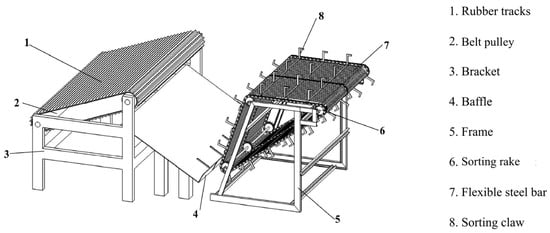
Figure 3.
Diagrammatic representation of a sorting and conveying apparatus.
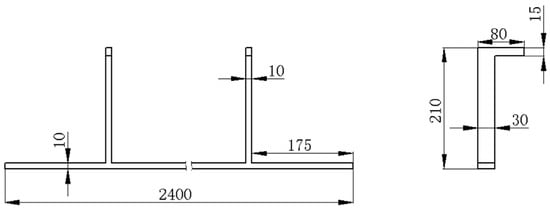
Figure 4.
Geometric parameters of the sorting hook claw.

Table 1.
Parameters of the sorting conveyor structure.
2.3. Analysis of the Motion of Sugarcane on a Cane Collection Plate
Sugarcane falls from the lifting conveyor belt and collides with the cane collection plate; if the cane rebounds too high, the entire cane stalk cannot slide or roll downward at the same time, the angle between the cane and the bottom end of the collection plate is too large, and the sorting hook claw cannot sort the cane effectively. So, it is necessary to analyze the cane collision process, as shown in Figure 5.

Figure 5.
Schematic of sugarcane collision.
Assuming that the cane falls from the lifting conveyor belt to the cane collecting plate at an effective height of , the rebound effect can be determined using the mechanical energy conservation theorem just before the cane collides with the cane collection plate:
where is the mass of the sugarcane, is the cane’s speed prior to impact with the ramps, and is the initial velocity of falling sugarcane.
The collision between the cane and the cane collector plate is not entirely elastic due to the significant difference in their elastic moduli and the kinetic energy loss that occurs during the collision process. The coefficient of restitution, or e, is the ratio of the separation velocity and the approaching velocity of the two objects prior to and following the collision along the direction normal to the contact place, and it can only be obtained using the material of the collision object:
where is the inclination of the cane plates, and is the cane’s velocity after rebounding perpendicular to the sloped plate.
Using the kinematics equation and the cane’s center of mass at the moment of impact as the origin, a coordinate system is created in the x-axis direction:
where is the cane velocity toward the collecting plate following contact rebound, is the greatest vertical distance from the cane collection plate following cane rebound, is the amount of time following cane rebound before the cane collection plate reaches its maximum vertical distance, is the distance in the cane decline direction that corresponds to the cane touching the cane collection plate again after rebounding, and is the interval between the cane’s greatest vertical separation from the collection plate and the moment at which it makes contact with the plate once more.
In the direction of the y-axis, the following applies:
where is maximum distance following cane rebound that is perpendicular to the cane collection plate.
The angle of the clamping of the collector plate and the angle of springing up have the following relationship, which may be derived from the geometric relationship in the Figure 5:
Following the collision, the cane’s maximum bouncing height is determined by couplings (1)–(5) as follows:
The height of the falling cane and the inclination angle α of the cane collection plate are connected to the maximum height of the cane that bounces up after contact, according to Equation (6).
The cane slips downhill after colliding with the cane collection plate because it is not a perfect cylinder, and its leaf-covered stem makes it difficult to adhere to rolling circumstances. The inclination angle of the plate affects how quickly the sugarcane slides down along the cane collection plate. If the inclination angle is too small, the sugarcane slides down too slowly, making it easy for the sorting organization to miss the catch; if the inclination angle is too large, the sugarcane slides down and piles up at the bottom end of the plate, making sorting difficult. Therefore, to ensure that the cane slides down evenly and neatly and maintains a specific interval, the cane collection plate’s inclination angle should be kept reasonable.
Additionally, the sorting speed of the sorting mechanism has a significant impact on how well sugarcane is sorted. The speed should be set within a reasonable range because if it is too fast, the sorting hook claw will pass through the cane collection plate before the sugarcane has slid to the bottom, which could result in missed grasping; if it is too slow, the sugarcane may stack, which is not good for sorting.
3. Simulation Test Analysis of Sorting and Conveying Process
In order to verify the feasibility of the device, a single-factor virtual test is first conducted to initially determine the factors affecting the performance of the device, which provides a theoretical basis for the subsequent verification of the physical prototype.
3.1. Parameterization and Modeling for Simulations
To fulfill Adams’ simulation criteria and lower the computer’s running burden, the sorting and conveying model must be properly reduced. The simulation primarily examines the sugarcane conveying process and the collision process that occurs after the sugarcane falls. During the conveying process, sugarcane is mostly susceptible to contact force between the cane stems, which is insufficient to cause the cane stems to undergo significant deformation. With a length of 2500 mm, a diameter of 30 mm, a density of 1.1 × 10−6 kg/mm3, a modulus of elasticity of 1310 Mpa, a Poisson’s ratio of 0.33 [23], and a set of stacking contact between the cane stems, the cane is simplified as a cane stem model because the collision force after the cane falls is primarily related to cane mass and geometry and has nothing to do with material flexibility.
The sorting and conveying device has a lot of pieces, and its structure has been streamlined to save simulation time while still satisfying virtual test criteria. To conceal the wire mesh of the sorting mechanism, the rows of canes on the cane collecting plate are arranged horizontally, and 40 canes are pre-installed on the lifting conveyor belt. This simplifies the lifting conveyor belt by using a conveyor model with baffles. Steel material with a density of 7850 kg/cm3, a Young’s modulus of 20,700 MPa, and a Poisson’s ratio of 0.3 is used for the frame, sprocket, cane collection plate, and sorting mechanism [24]. Figure 6 displays the simplified simulation model.
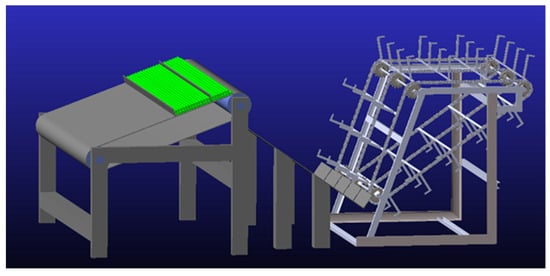
Figure 6.
Simulation model for sorting and conveying.
For cane-lifting conveyor belt, cane-collecting plate, cane-sorting claw, cane–cane, and chain-link contact, the appropriate contact parameters are determined. The collision force between two elements is determined using the IMPACT function and is composed of two components: a dampening force caused by the relative velocity [25] and an elastic force resulting from the mutual incision between the two members. It is stated as follows:
where is the initial distance between the two objects to collide, is the actual distance between the two objects during the collision, is the rate of the change in the distance between the two objects with time, i.e., the velocity, is the stiffness coefficient, is the collision index, is the maximum damping coefficient, and is the depth of incision, which determines when the damping force reaches its maximum. To prevent a discontinuity of the damping force in the process of a collision, use Eq. function [26] in the form of :
where
For collisions of rotating objects, the stiffness coefficient can be approximated by approximating the following equation:
where
where and are the radii of the two objects at the collision, respectively; and are the Poisson’s ratios of the two objects, respectively; and and are the elastic moduli of the two objects, respectively.
The default value in ADAMS can be used to compute the stiffness factor for collisions with non-rotating bodies [27]. The loss of impact energy is described by the maximum damping factor (Damping), which is typically set between 0.1 and 1% of the stiffness factor. The depth of the incursion at which dampening is the greatest is described as penetration depth. There is no damping force when the impact is merely a collision; however, as the depth of an intrusion rises, the damping force increases until it reaches the maximum damping force, which is typically set at 0.1 mm [28,29]. Information on the particular contact characteristics displayed in Table 2 may be found in References [30,31,32].

Table 2.
Contact parameters for the simulation.
3.2. Single-Factor Simulation Experiments
According to the literature [33], the influence of the inclination angle of the guide cane board on cane attitude is analyzed, and combined with the pre-test of cane falling. It can be seen that when the inclination angle of the cane collection board is at least 25°, the whole stalks of the cane can slide down along the board more smoothly. When the inclination angle is more than 45°, the fallen canes rapidly pile up at the bottom of the board, which is not conducive to the sorting. Consequently, it is important to maintain the cane collecting plate’s inclination angle between 25° and 45°.
The conveying speed of the sorting mechanism should meet the following equation, since the leaf stripping efficiency of sugarcane leaf stripping equipment should satisfy 10 t/h based on the national agricultural industry specification “NY/T 2903-2016 Technical Specification for Quality Evaluation of Sugarcane Harvester” and actual operation:
where is the leaf stripping efficiency, is the circumference of the sorting mechanism chain, is the average mass of a single cane, is the number of cane sorting roots, and is the number of sorting rakes.
The circumference of the chain of the sorting mechanism is 5.75 m, the average mass of the unpeeled sugarcane is about 1.8 kg, the number of sugarcane sorting roots is three, and the number of sorting rakes is 12. Substituting the data into Formula (13), we can obtain a of 0.246 m/s, the known radius of the sprocket wheel is 0.1 m, and we can ascertain that the angular velocity of the sprocket wheel is 2.46 rad/s, i.e., 24 r/min. When combined with the literature [34], it is evident how chain shaft speed affects the effectiveness of cane seed filling and conveying: the lower the rotational speed, the better the effect of seed filling and conveying. However, a rotational speed that is too low will reduce work efficiency, so the sorting mechanism’s sprocket wheel’s rotational speed will be regulated between 16 and 32 r/min.
Based on the experience of manually assisted sorting, blockages may be successfully avoided while sorting three canes at once. Additionally, the pull-type sugarcane defoliation equipment’s quality and efficiency meet industry standards when feeding three canes at once. Thus, this test evaluates the effectiveness of the sorting and conveying mechanism and uses the percentage of three canes sorted by the sorting mechanism as the test index. The higher the percentage of sorting three canes, the better the solution.
The following formula determines the percentage of sorted roots :
where is the number of times three canes were sorted, and is the time spent sorting.
Through the simulations, which were split into two groups, the sorting and conveying device’s sorting effect and conveying stability were examined. The first set of tests examined the impact of stable sugarcane transportation under various cane collection plate inclination angles. The cane collection plate inclination angles were set at 25°, 30°, 35°, 40°, and 45°. The sprocket wheel of the sorting mechanism rotated at a speed of 24 r/min. The lifting conveyor belt conducted five tests, sorting 40 pieces of sugarcane in each test. The second group examined how different sorting mechanism sprocket speeds affected the sorting effect. They used the following parameters: the amount of pre-sorted sugarcane was 40, the inclination angle of the cane collecting plate was set at 35°, the sorting mechanism sprocket speeds were 16, 20, 24, 28, and 32 r/min, and the same five tests were conducted.
3.3. Analysis of Simulation Results
Figure 7 shows that when the inclination angle of the set cane plate is small, the sugarcane falls on the set cane plate, there is a certain offset, and the sugarcane slides down slowly. When the distance between neighbors is larger, the sugarcane at the bottom end of the set cane plate is sorted by the sorting organization; when it is smaller, the amount of sugarcane sorted by the sorting organization is smaller, usually consisting of 1–2 roots. The number of sorted canes is often two to three canes because the cane displacement during the downward sliding operation is minimal, and the distance between adjacent canes is appropriate when the collecting plate’s inclination angle is 35°. As the cane collecting plate’s inclination angle increases, the cane’s gravitational force increases as well. This causes the cane to collide with the plate and then slide rapidly to the bottom. The conveying process becomes less continuous and less orderly, which leads to uneven sorting by the sorting organization.
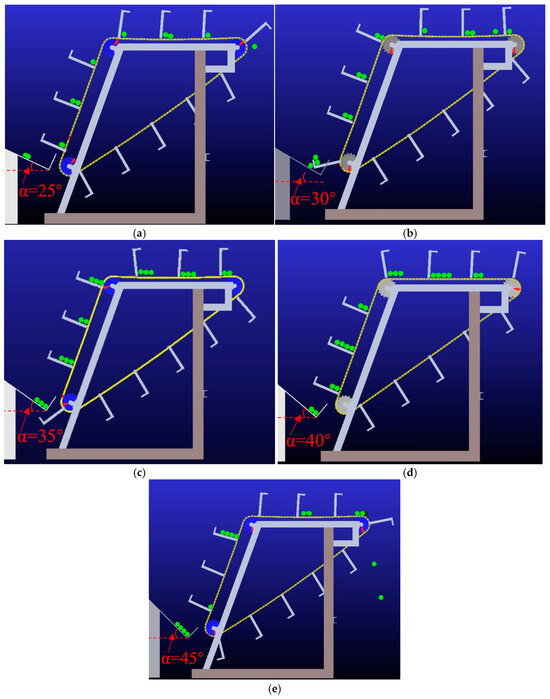
Figure 7.
Process of simulating various cane collection plate inclination angles. (a) Represents the sorting of sugarcane at = 25°; (b) represents the sorting of sugarcane at = 30°; (c) represents the sorting of sugarcane at = 35°; (d) represents the sorting of sugarcane at = 40°; and (e) represents the sorting of sugarcane at = 45°.
Figure 8 shows the simulation results for different sprocket speeds of the sorting system. As seen in Figure 8, the higher the sprocket wheel’s rotational speed, the faster the sorting mechanism’s sorting speed is, and the fewer equivalent sorting hook claws there are each time, even leading to the occurrence of empty hooks. Conversely, when the sprocket’s rotational speed decreases, the frequency of sorting decreases as well. A certain amount of sugarcane may accumulate at the bottom of the cane collection plate, increasing the number of cases where two or three canes need to be sorted. However, if the sprocket’s rotational speed is too slow, it is easy for the sorting mechanism to fail to grasp the sugarcane in time, causing it to pile up at the bottom of the cane collection plate, which reduces the sorting effect.
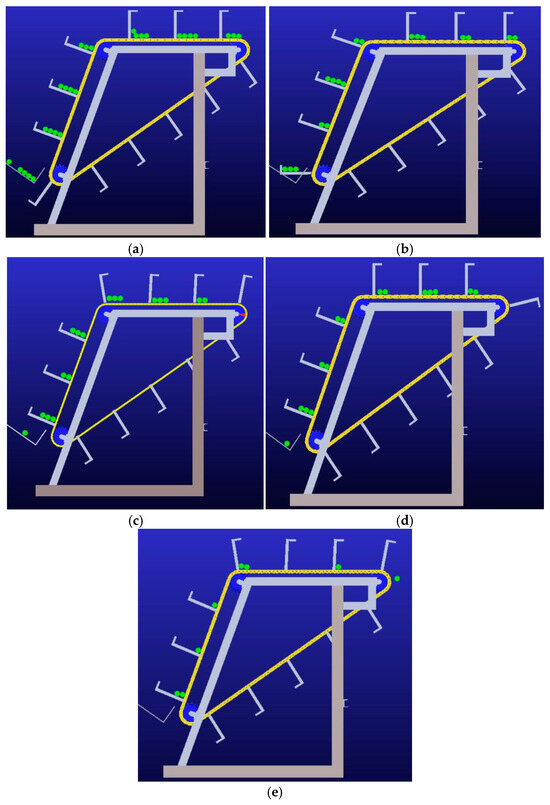
Figure 8.
Process of simulating various sprocket speeds. (a) Represents the sprocket speed of 16 r/min; (b) represents the sprocket speed of 20 r/min; (c) represents the sprocket speed of 24 r/min; (d) represents the sprocket speed of 28 r/min; and (e) represents the sprocket speed of 32 r/min.
3.4. Two-Factor Level Test
In identifying the best operating conditions for the sorting and conveying device, the one-factor simulation test process revealed that the sorted sugarcane was primarily 2–3 canes when the cane collection plate’s inclination angle was between 25° and 35°. The sorting effect was also relatively good when the sprocket wheel’s rotational speed was between 20 and 28 r/min. For this reason, this range was chosen for the two-factor test to see if the interaction between the two factors had any effect on the test indexes. Table 3 lists the two-factor test’s factor levels and factor codes. A and B stand for the cane collecting plate’s inclination angle and the sprocket rotational speed, respectively, and the test was conducted three times at each level. Table 4 displays the design and findings of the simulation experiment on the percentage of sorting three canes.

Table 3.
Test factors and levels.

Table 4.
Simulation experimental design and results for sorting the three-cane occupancy ratio.
The experimental results were analyzed using two-factor repeated measures ANOVA through SPSS 29.0.2.0(20), and the results are shown in Table 5. The effect of both cane collection board inclination angle and sprocket speed on the percentage of sorted three roots reached a significant level (p < 0.05), with cane collection board inclination angle having a greater influence than sprocket speed. In addition, the interaction between the inclination angle of the collecting board and the sprocket rotation speed during the test reached the level of p < 0.05, so the interaction between the inclination angle of the collecting board and the sprocket rotation speed on the test indexes reached a level of significance. Therefore, it is necessary to analyze the interaction effect of the inclination angle of the collecting board and the sprocket rotation speed, shown in Figure 9. When the inclination angle of the collecting board is 25°, the sprocket rotation speed is faster, and the ratio of sorting three canes is smaller; when the inclination angles of the cane collection plate are 30° and 35°, with an increase in sprocket rotational speed, the percentage of sorting three canes increases and then decreases. When the inclination angle of the cane collection plate is 30° and the sprocket rotational speed is 24 r/min, the percentage of sorting three canes is the highest and reaches 87.96%, i.e., the sorting effect of the sorting mechanism under this factor level is the best.

Table 5.
Analysis of variance.
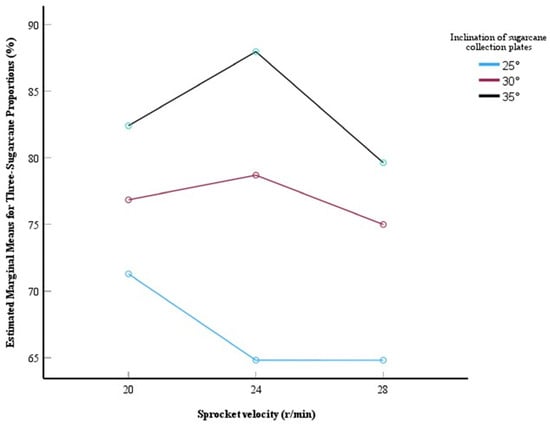
Figure 9.
Estimated marginal means for three-sugarcane proportions.
4. Experiment and Analysis
4.1. Experimental Materials and Methods
To further validate the simulation findings, a physical prototype test was carried out in Longxin Village, Jinde Town, Liujiang District, and Liuzhou City. The variety of sugarcane used for this test was Gui Sugar 44, and the diameter of the sugarcane ranged from 25 to 32 mm, with each cut off at the root position. To exclude the interference of other factors on the validation test as much as possible, the length of the whole stalks of the sugarcane used for the test was similar, which was about 2.5 m, and the stems of the sugarcane were in a straight culm state, without obvious bending. After harvesting, sugarcane should be transferred for leaf stripping as soon as possible to avoid affecting the test results due to dehydration. The primary test apparatus consists of a digital display level meter (range 90°, accuracy 0.1), an electronic scale (range 0~300 kg, precision 0.01 kg), a tape measure, and a DT-2234B photoelectric tachometer (range 0~99,999 r/min, precision 0.1 r/min). The functional components, such as thickening the cane collection plate and modifying the bracket mounting position, are correctly adjusted based on the actual installation and operation, provided that the influence of sorting and conveying parameters stays constant. Figure 10 depicts the test configuration.
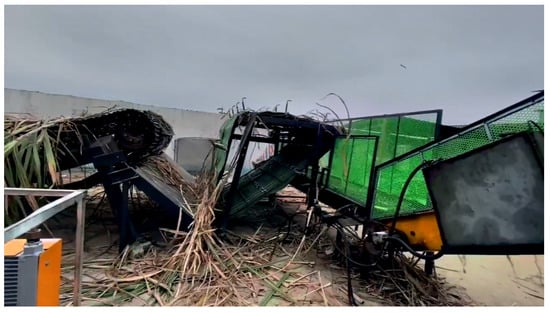
Figure 10.
Conveyor for sorting.
Based on the simulation results, set the sprocket wheel speed to 24 r/min and the inclination angle of the cane collection plate of the sorting and conveying device to 35°. Then, when the device is operating steadily, the manipulator begins to pick up the sugarcane that is scattered on the loading platform. Since sugarcane leaf stripping equipment uses cane tail feeding first, the sugarcane’s tail must point in the same direction as the straight conveying channel when loading. Three complete revolutions of the sorting mechanism (36 rotations total) were used as a series of tests, and records were kept beginning with the second time the sorting hook claw gripped the sugarcane. Ten sets of tests were conducted under typical working conditions, and the number of times the sorting hook claw hooked and the number of sugarcane roots it hooked each time were recorded. The percentage of sorted sugarcane roots for each test group, based on the experimental data that were recorded, was determined, then the validation test was examined. The percentage of sorted roots may be computed using the formula below:
where is the number of times cane was sorted, and = 0, 1, 2, 3, 4….
4.2. Experimental Results and Analysis
Table 6 displays the computed results of the percentage of sorted sugarcane roots for each trial group. As shown in the table, the average proportions of sugarcane sorting in the 10 experimental groups were as follows: 0 stalks (10.28%), 1 stalk (3.61%), 2 stalks (4.45%), 3 stalks (80.56%), and 4 stalks (1.11%). This indicates that the experimental value of the physical prototype (80.56%) is smaller than the simulation value (87.96%), with a relative error of 8.4% between the two. The deviation between the experimental and simulated results falls within an acceptable range. According to Reference [35], when the number of fed sugarcane stalks is ≤3, the leaf stripping device operates smoothly. However, the blockage rate of the device increases, and its throughput efficiency decreases as the number of fed stalks rises. Notably, the proportion of sorted sugarcane with four stalks in this experiment is only 1.11%, demonstrating that the sorting mechanism achieves effective performance. Furthermore, this throughput effectively avoids the blockage caused by overfeeding sugarcane.

Table 6.
Sorting and communicating the findings.
Examine the causes of the error as follows: (1) Obtain test samples are sugarcane that has recently been harvested and transferred, including the leaves and tips. During the collection and transfer process, the leaves and stems of the sugarcane will become entangled with one another, making it difficult for the sugarcane to spread out during the sorting and conveying process. In addition, there are differences in diameter or morphology between individual sugarcane stalks, which will also affect the transportation process, and the simulation process simplifies the sugarcane, so there is a certain error in the sorting effect. (2) The simulation assumes that the feed for each test is a fixed 40 sugarcane, and the fluctuation of the feed has a certain error on the sorting effect. However, in the test process, because the manipulator’s process of grasping the sugarcane for feeding is not continuous, there will be a situation in which the lifting conveyor belt is unable to continuously and stably convey the sugarcane into the gap in the sugarcane feeding mechanism. This results in an increase in the proportion of 0 sugarcane sorted by the sorting mechanism. (3) While the simulation test idealizes the rigidity and motion control of the equipment, the field environmental conditions (such as dust, vibration, etc.) have an impact on the stability of the physical prototype’s operation. As a result, there are some errors in both the simulation and the physical prototype test results.
5. Conclusions
The step-by-step sugarcane harvesting model is tailored to China’s diverse sugarcane cultivation, but there is a significant gap in the research regarding the front-end conveying system of the relevant tension-type sugarcane defoliation equipment, necessitating the design and development of a uniform and efficient conveying device. As a result, this research develops a three-dimensional model of a sorting and conveying device and conducts both simulation and physical prototype testing of the sugarcane sorting and conveying process. The key findings are as follows:
- (1)
- In order to address the issues of step-by-step sugarcane harvesting and stripping equipment’s inability to efficiently sort and transport the sugarcane in the pile—which is prone to clogging, necessitates manual sorting, and fails to realize the entire mechanized operation, etc.—a sorting and transporting device comprising a lifting conveyor belt, a cane collecting plate, and a sorting mechanism has been designed. The collision process between the sugarcane and the collecting plate has been examined, and it has been found that the two variables influencing the sorting and transporting are the plate’s angle of inclination and the sprocket’s rotation speed (sorting speed)
- (2)
- Based on the ADAMS simulation, the influence mechanisms of the cane collecting plate inclination angle and sprocket rotational speed on the percentage of sorting three canes is studied. The simulation study shows that the percentage of sorting three canes is significantly impacted by the inclination angle of the cane collector plate, the sprocket wheel’s rotational speed, and the interaction between the sprocket wheel’s rotational speed and the cane collector plate’s inclination angle. After analyzing the interaction effect, it was determined that when the inclination angle of the cane collecting plate was 35° and the rotating speed of the sprocket wheel was 24 r/min, the sorting three cane percentage attained the ideal value of 87.96%.
- (3)
- Based on the simulation’s optimal parameters, the sorting and conveying device’s physical prototype was tested and analyzed. The average percentage of sorting three sugarcane was 80.56%, which was lower than the simulation’s value of 87.96%; the relative error between the simulation and test values for the percentage of sorting three sugarcane was 8.4%, and the average percentage of sorting four sugarcane was 1.11%, which fell within a reasonable error range. These results showed that the sorting and conveying device was feasible and practical, and that it could sort sugarcane and avoid blockages. It demonstrates that this sorting and conveying mechanism can efficiently sort sugarcane while preventing blockages, which is both realistic and useful.
This paper concludes a simulation analysis and experimental research on the effects of the sprocket speed of a sorting conveyor device and the inclination angle of the cane collecting plate on the stable conveying and efficient sorting of sugarcane, respectively, based on the pull-type sugarcane defoliation equipment developed by the group. The sorting impact of sugarcane is influenced by various combinations of sprocket rotation speed and raising conveyor belt speed (loading speed). The sensors that measure the sugarcane’s quality on the loading platform and modify the loading speed might be used in future studies. Furthermore, the sugarcane was defaulted to the straight stalk state during the research process, and experimental validation was also performed on relatively straight sugarcane. In contrast, there was a deficiency in the theoretical research and experimental analysis of curved sugarcane, which can be examined further. To reduce the amount of computer calculations, this paper substitutes a cylindrical rigid body for the sugarcane model in the simulation of the sugarcane sorting and conveying process, due to the limitations of the author’s computer equipment. However, this simplification may overlook the flexibility, surface texture, and potential bending deformation of actual sugarcane, which could affect the conveying state in a real collision. As a result, a more realistic model of sugarcane may be created using more potent computational equipment. This model can then be fine-tuned and parameterized to better replicate the sugarcane’s condition during the conveying process.
Author Contributions
Conceptualization, Y.Z., J.L. and W.F.; methodology, Y.Z.; software, Y.Z., J.L. and W.F.; validation, Y.Z. and W.F.; formal analysis, J.L. and W.F.; investigation, Y.Z. and W.F.; resources, J.L.; data curation, Y.Z. and J.L.; writing—original draft preparation, Y.Z.; writing—review and editing, J.L. and W.F.; visualization, Y.Z.; supervision, J.L. and W.F.; project administration funding acquisition, J.L. All authors have read and agreed to the published version of the manuscript.
Funding
This research was funded by the National Natural Science Foundation of China, grant number 51965003.
Institutional Review Board Statement
Not applicable.
Informed Consent Statement
Not applicable.
Data Availability Statement
Data are contained within the article.
Conflicts of Interest
The authors declare no conflicts of interest.
References
- Ikram, K.; Niaz, Y.; Mansha, M.Z.; Ghani, M.U.; Shabir, F.; Waqas, M.M.; Bodlah, M.A.; Nadeem, M.; Afzal, A.; Omer, M.M.; et al. Cleaning Material Arrangement Testing for Sugarcane Detrasher: A Simulation Approach. Big Data Agric. 2020, 2, 65–68. [Google Scholar] [CrossRef]
- Zhou, B.C.; Ma, S.C.; Li, W.Q.; Li, W.Z.; Pen, C. Study on the Influence Mechanism of Energy Consumption of Sugarcane Harvester Extractor by Fluid Simulation and Experiment. Agriculture 2023, 13, 1726. [Google Scholar] [CrossRef]
- Li, Z.; Lin, Z.L.; Li, S.Y.; Zhang, H. Optimization research on the working parameters of sugarcane harvester on the cutting time of stalks using virtual prototype technology. Sugar Tech 2023, 25, 41–56. [Google Scholar] [CrossRef]
- Singh, A.K.; Solomon, S. Development of a sugarcane detrasher. Sugar Tech 2015, 17, 189–194. [Google Scholar] [CrossRef]
- Xie, F.X.; Song, J.; Zhang, X.L.; Zhang, L. Analysis and experiment on sugarcane leaf isolation of whole-stalk sugarcane harvesters. Int. Agric. Eng. J. 2019, 28. [Google Scholar]
- Shang, J.D.; Wang, Z.; Hu, D.F. Research on the Leaf-Stripping Device of Whole Stalk and Small-Scale Sugarcane Combine Harvester. Appl. Mech. Mater. 2014, 488, 1181–1184. [Google Scholar] [CrossRef]
- Ma, S.; Karkee, M.; Scharf, P.A.; Zhang, Q. Sugarcane harvester technology: A critical overview. Appl. Eng. Agric. 2014, 30, 727–739. [Google Scholar]
- Chen, M.D.; Lu, J.P.; Lin, Y.D.; Feng, W.K.; Zhong, Y.L. Research on operation parameters of leaf cleaning element of pulling type sugarcane leaf-stripping machine. J. Chin. Agric. Mech. 2024, 45, 122–126. [Google Scholar]
- Mou, X.W.; Ou, Y.G.; Liu, Q.T.; Zeng, Z.Q. Analysis on leaf-stripping effect of sugarcane feeding way for centrifugal leaf-stripping machine. In Proceedings of the 2011 International Conference on New Technology of Agricultural, Zibo, China, 27–29 May 2011; pp. 19–23. [Google Scholar]
- Xie, L.; Wang, J.; Cheng, S.; Hu, J. Improved design and experiment of whole stalk operating system after sugar cane severing. In Proceedings of the 2016 ASABE American Society of Agricultural and Biological Engineers Annual International Meeting, Orlando, FL, USA, 17–20 July 2016; p. 1. [Google Scholar]
- Kent, G.A. Issues Associated with Using Trash as a Cogeneration Fuel. Sugar Tech 2014, 16, 227–234. [Google Scholar] [CrossRef]
- Patel, A.; Moses, S.C.; MD’Souza, P.; Alam, R.N. Design, fabrication and performance evaluation of tractor operated sugarcane leaf stripper for labour saving and cost reduction machinery in sugarcane. Pharma Innov. J. 2022, 11, 505–511. [Google Scholar]
- Ikram, K.; Ahmad, M.; Ghafoor, A.; Tanveer, A. Design, fabrication, and performance evaluation of indigenous sugarcane leaf stripping machine. Pak. J. Agric. Sci. 2019, 56, 451–457. [Google Scholar]
- Jadhav, U.; Khot, L.R.; Ehsani, R.; Jagdale, V.; Schueller, J.K. Volumetric mass flow sensor for citrus mechanical harvesting machines. Comput. Electron. Agric. 2014, 101, 93–101. [Google Scholar] [CrossRef]
- Taghanaki, S.A.; Zheng, Y.; Zhou, S.K.; Georgescu, B.; Sharma, P.; Xu, D.; Comaniciu, D.; Hamarneh, G. Combo loss: Handling input and output imbalance in multi-organ segmentation. Comput. Med. Imaging Graph. 2019, 75, 24–33. [Google Scholar] [CrossRef]
- Szegedy, C.; Vanhoucke, V.; Ioffe, S.; Shlens, J.; Wojna, Z. Rethinking the inception architecture for computer vision. In Proceedings of the IEEE Conference on Computer Vision and Pattern Recognition, Las Vegas, NV, USA, 27–30 June 2016; pp. 2818–2826. [Google Scholar]
- Yamada, T.; Mizuhara, N.; Yamamoto, H.; Matsui, M. A performance evaluation of disassembly systems with reverse blocking. Comput. Ind. Eng. 2009, 56, 1113–1125. [Google Scholar] [CrossRef]
- Xu, H.; Wu, T.; Liu, Q.; Zhang, Z.; Gan, X.; Liang, X. Investigation of the trajectory of expelled billets from the chopping rollers of a sugarcane harvester. Sugar Tech 2020, 22, 896–910. [Google Scholar] [CrossRef]
- Li, L. The logistics characteristics analysis on flexible conveying device of mini-type sugarcane harvester. Appl. Mech. Mater. 2013, 321, 201–204. [Google Scholar] [CrossRef]
- Shen, Z.H.; Li, S.P.; Ma, F.L.; Gao, J.L. Simulation and Experiment on Feed Ability of Small Sugarcane Harvester. Trans. Chin. Soc. Agric. Mach. 2014, 45, 117–123. [Google Scholar]
- Lai, X.; Chen, P.Z.; Li, S.P.; Wang, M.M.; Cheng, J.H.; Huang, H.R. Conveyor control system design and testing for sugarcane harvesters with complete stalks. Trans. Chin. Soc. Agric. Mach. 2023, 54, 121–128. [Google Scholar]
- Zhou, S.P.; Liu, Q.T.; Yang, T.D.; Huang, M.; He, T.F.; Huang, Z. Design and test of vertical clamping conveyor channel leaf stripping device for sugarcane. J. South China Agric. Univ. 2019, 40, 117–124. [Google Scholar]
- Luo, J.C.; Wen, S.; Li, H.G.; Liu, Q.T. Analysis of sugarcane tailstock’s Poisson’s ratio by experimentation. J. South China Agric. Univ. 2017, 38, 118–124. [Google Scholar]
- Ye, Z.L.; Wang, Y.X.; Tang, Y.Q.; Qiu, Z.G.; Luo, W.H.; Ren, G.F.; Zhao, Q.X. Dynamic Simulation Analysis of the Working Process of the Picking Mechanism of a Sugarcane Leaf Cutting and Returning Machine. Appl. Sci. 2023, 13, 1620. [Google Scholar] [CrossRef]
- Tan, J.Y.; Sha, J.L.; Zhang, W.Y. A study of the effect of Adams contact parameters on post-crash velocity. Low Carbon World 2017, 18, 283–284. [Google Scholar]
- Khemili, I.; Romdhane, L. Dynamic analysis of a flexible slider–crank mechanism with clearance. Eur. J. Mech. A/Solids 2008, 27, 882–898. [Google Scholar] [CrossRef]
- Yang, J.; Wang, X.J. Kinematics Simulation Based on ADAMS Belt Conveyor Rollers. Adv. Mater. Res. 2014, 3227, 666–669. [Google Scholar] [CrossRef]
- Hu, Y.H.; Feng, J.Z.; Qiao, Y.C.; Yu, C.H.; Luo, W.K.; Zhang, K.L.; Liu, R.F.; Han, R.Z. Research and Validation of Vibratory Harvesting Device for Red Jujube Based on ADAMS and ANSYS. Agriculture 2023, 13, 1334. [Google Scholar] [CrossRef]
- Pei, W.C.; Li, Y.G.; Li, Y.H. Modeling impact forces with ADAMS virtual prototyping technology. J. North China Univ. Sci. Technol. (Nat. Sci. Ed.) 2008, 4, 59–63. [Google Scholar]
- Wu, T.; Li, F.; Liu, Q.; Ren, J.; Huang, J.; Qin, Z. Numerical Simulation and Analysis of the Impurity Removal Process of a Sugarcane Chopper Harvester Based on a CFD–DEM Model. Agriculture 2024, 14, 1392. [Google Scholar] [CrossRef]
- Ma, F.L.; Teng, X.; Li, K.; Li, S.P.; Wu, F. Simulation Analysis of Roller Rake Structure of Replanting Device for Sugarcane Horizontal Planter. J. Agric. Mech. Res. 2024, 46, 48–52. [Google Scholar]
- Xie, L.X.; Wang, J.; Cheng, S.M.; Zeng, B.S.; Yang, Z.Z. Optimisation and dynamic simulation of a conveying and top breaking system for whole-stalk sugarcane harvesters. Biosyst. Eng. 2020, 197, 156–169. [Google Scholar] [CrossRef]
- Ma, F.L.; Li, J.H.; Duan, R.G.; Chen, B.; Chen, J.S. Experimental Study on the Interconnection of Seed Supply and Seeding System of Sugarcane Planters. J. Agric. Mech. Res. 2024, 46, 153–161. [Google Scholar]
- Ma, F.L.; Liu, T.X.; Li, S.P.; Luo, X.H.; Wu, F.; Wang, Y.F. Design and test of transverse transplanter for pre-cut sugarcane. Trans. Chin. Soc. Agric. Mach. 2020, 5, 7. [Google Scholar]
- Lai, X.; Chen, S.; Chen, P.Z.; Chen, D.J. Simulation and Experiment of Blockage of Conveyor System of Sugarcane Harvester. J. Agric. Mech. Res. 2025, 1–9. [Google Scholar]
Disclaimer/Publisher’s Note: The statements, opinions and data contained in all publications are solely those of the individual author(s) and contributor(s) and not of MDPI and/or the editor(s). MDPI and/or the editor(s) disclaim responsibility for any injury to people or property resulting from any ideas, methods, instructions or products referred to in the content. |
© 2025 by the authors. Licensee MDPI, Basel, Switzerland. This article is an open access article distributed under the terms and conditions of the Creative Commons Attribution (CC BY) license (https://creativecommons.org/licenses/by/4.0/).